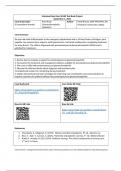Maryland Next Gen NCLEX Test Bank Project
September 1, 2022
Case Study Topic: (& standalone bowtie) Post-Strep Glomerulonephritis
(pediatric)Author:Heidi Bresee, DNP , PPCNP-BC, RN
Frederick Community College
Case Summary
Six-year-old male child presents to the emergency department with a 24-hour history of fatigue, poor appetite, tea-colored urine, oliguria, mild hypertension, and facial swelling after completing treatment
for strep throat. The child is diagnosed with poststreptococcal glomerulonephritis (PSGN) and is admitted for treatment. Objectives 1. Review how to evaluate a patient for poststreptococcal glomerulonephritis
2. Summarize the treatment and management options available for poststreptococcal glomerulonephritis
3. Plan care of child with poststreptococcal glomerulonephritis
4. Educate the child and family about diagnosis and treatment plan
5.Comprehend reasons for monitoring during treatment
6. Explain interprofessional team strategies for improving care coordination and communication to improve outcomes for patients affected by poststreptococcal glomerulonephritis
Case Study Link Case Study QR Code
https://umaryland.az1.qualtrics.com/jfe/form/
SV_8cQvohVkmgfi6Wy
Bow-tie QR Code Bow-tie Link
https://umaryland.az1.qualtrics.com/jfe/form/
SV_cMC6Er1EvqR3G3c
References
1.Marcdante, K., Kliegman, R. (2019). Nelson essentials of pediatrics , 8th ed. ,Elsevier, Inc. 2.Ricci, S., Kyle, T., Carman, S. (2021). Maternity and pediatric nursing, 4th ed., Wolters Kluwer. 3.Rudd, K., Kocisko, D. (Ed.) (2019). Pediatric nursing: The critical components of nursing care, 2nd ed. F. A. Davis.
CJCST Version 2.1 designed by Desirée Hensel, 2022. Permission granted to use and modify template for educational purposes. Case Study Question 1 of 6 The parent brings a 6-year-old male child to the emergency department with new symptoms after completing treatment for strep throat.
Nurses’ Notes
0800: Parents report the child developed fatigue, loss of appetite, and a headache yesterday. Today they noticed the child’s face was swollen, and his urine output was decreased. History includes recently completing 8 days of amoxicillin for strep throat but ended treatment 2 days early when symptoms improved. Child was previously healthy, taking only multivitamins daily. Parent tried having the child increase his intake of fluids, but the output did not change, and his urine is now tea-colored. Vital signs: T-98.2 F (36.78C), HR 110, RR 22, B/P 128/80, pulse oximeter 99% on RA, pain scale of “3.” Periorbital edema present. Child placed in treatment room. Connected to cardiac and pulse oximeter monitor. Labs drawn.
Drag the 4 findings are most significant to the box on the right.
Client Findings Top 4 Findings
Blood pressure*
Periorbital ddema*
Poor appetite
Headache
Fatigue
Urine output*
Increased intake of fluids
History of strep throat*
Scoring Rule: 0/1
Rationale: The blood pressure for an 8 year-old should be less than 120/80. The history of recent strep throat, blood pressure, periorbital edema and changes in urine output are the most significant findings because they suggest the child has poststreptococcal glomerulonephritis. The child is at risk for heart failure, seizures, and encephalopathy due to hypertension and fluid overload as evidenced by bilateral periorbital edema, decreased urine output, hematuria, and high blood pressure of 128/80. CJCST Version 2.1 designed by Desirée Hensel, 2022. Permission granted to use and modify template for educational purposes.




